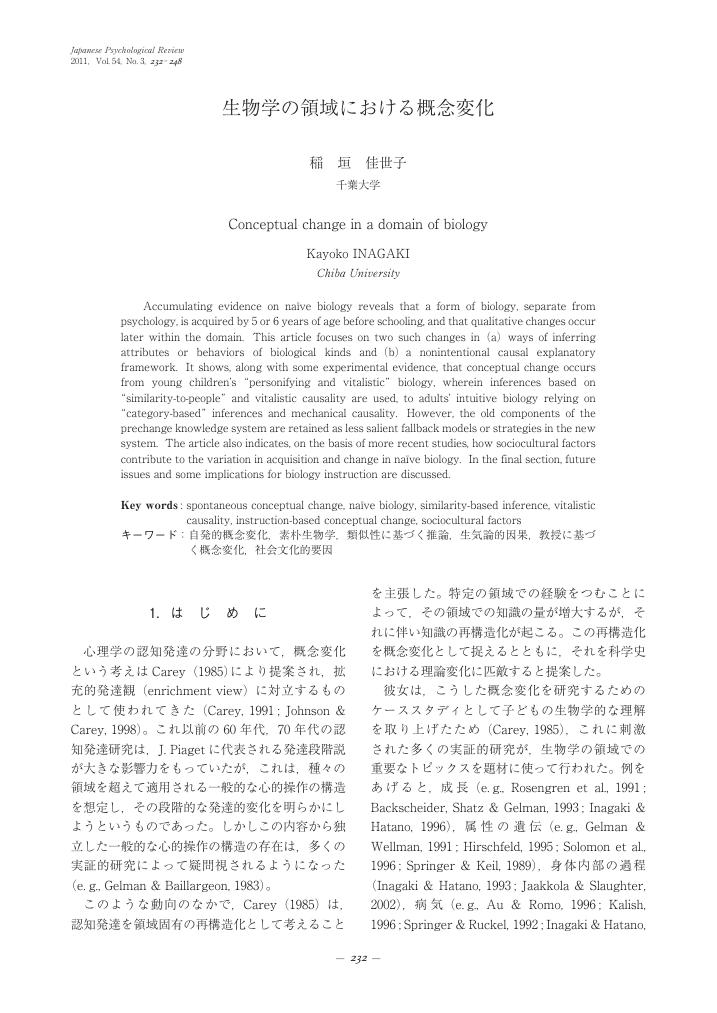1 0 0 0 OA 生物学の領域における概念変化
- 著者
- 稲垣 佳世子
- 出版者
- 心理学評論刊行会
- 雑誌
- 心理学評論 (ISSN:03861058)
- 巻号頁・発行日
- vol.54, no.3, pp.232-248, 2011 (Released:2018-08-18)
1 0 0 0 OA 認知的観察における内発的動機づけ
- 著者
- 稲垣 佳世子 波多野 誼余夫
- 出版者
- 一般社団法人 日本教育心理学会
- 雑誌
- 教育心理学研究 (ISSN:00215015)
- 巻号頁・発行日
- vol.16, no.4, pp.191-202,251, 1968-12-15 (Released:2013-02-19)
- 参考文献数
- 10
- 被引用文献数
- 13 11
The present study aimed at investigating motivational influences on epistemic observation of a physical phenomenon. Two experiments, which followed Pre-test-Instruction-Post-test paradigm, were undertaken. Ss of 2 experimental groups were motivated for observation by receiving information discrepant with their prior beliefs.One hundred and twenty-five 3rd-graders served as Ss of the 1st experiment. In the Instruction session, they observed and confirmed by a scale conservation of weight under deformations of a clay ball, and under changes of man's posture. Immediately before the observation, pupils of a group termed “Discrepant Information Group” (DI) were shown a table of response frequencies about conservation by an experimenter. Distribution of responses, which were pretended to be opinions of pupils of another, was markedly differnt from theirs, Ss of a “Discussion Group” (D) were required to anticipate conservation or non-conservation and to debate on the question. Control Group (C) Ss were given neither of these experimental manipulations.The results were as follows:1) Ss who observed the event after incongruity was aroused (as in DI) could recognize the event more accurately and could more readily generalize the principles of conservation.2) If Ss were strongly committed to a certain belief (as in D), they often conceptualized ambiguous results in a biased manner, making them consistent with the belief.As to generality of learning, however, performance of D Ss did not differ significantly from that of C Ss. This result was an unexpected one. Its interpretation was that there was low incongruity in D, because proponents of conservation were highly predominant at the discussion.In order to verify the interpretation mentioned above, the 2nd experiment was undertaken. Eighty-seven 4th-graders observed and confirmed by a scale conservation of weight under dissolution of sugar into water. One school class was assigned to C. Two groups of 22 pupils, of whom 2/3 were non-conservers, were selected from 2 other classes and served as D. They were expected to experience high incongruity during the discussion.The results showed that, compared with C, improvement of performance was greater among D. They could state adequate explanations of conservation of weight, generalize more readily the principles of conservation, and resist extinction (the observation of an apparently non-conserving event). Furthermore, Ss of D reported high epistemic curiosity.
1 0 0 0 OA ヒト知性の生得的基盤(<特集>知の起源)
- 著者
- 波多野 誼余夫 稲垣 佳世子
- 出版者
- 一般社団法人 人工知能学会
- 雑誌
- 人工知能 (ISSN:21882266)
- 巻号頁・発行日
- vol.18, no.4, pp.416-425, 2003-07-01 (Released:2020-09-29)
1 0 0 0 OA 発達2040 幼児の素朴生物学 (2) : 生気論的因果における「意図」
- 著者
- 波多野 諠余夫 稲垣 佳世子
- 出版者
- 日本教育心理学会
- 雑誌
- 日本教育心理学会総会発表論文集
- 巻号頁・発行日
- no.36, 1994-08-20
- 被引用文献数
- 1
1 0 0 0 IR 台湾における就学前児の注音記号と漢字の読み能力
- 著者
- 張 時〓 稲垣 佳世子
- 出版者
- 千葉大学
- 雑誌
- 千葉大学教育学部研究紀要. 第1部 (ISSN:05776856)
- 巻号頁・発行日
- vol.39, pp.241-249, 1991-02-28
1 0 0 0 OA 心のなかの文化の形成 : 認知発達への社会文化的接近(I.教育科学系)
- 著者
- 波多野 誼余夫 稲垣 佳世子
- 出版者
- 千葉大学
- 雑誌
- 千葉大学教育学部研究紀要 (ISSN:13482084)
- 巻号頁・発行日
- vol.53, pp.91-104, 2005-02-28
本論文において,人間の心が発達するのは,文化,すなわち何世代にもわたって蓄積され,共同体により共有された人工物を取り入れることによってである,と我々は提案する。我々のアプローチは認知的である。というのは,人間における知識と技能の獲得は,種々の内的ないし認知的制約のもとで行われると想定しているからである。我々のアプローチは社会文化的でもある。というのは,獲得された制約は,たいてい社会文化的な起源を持っており,人間は知識や技能を相互作用的な社会文化的制約のもとで獲得する,というのが我々の主張だからである。本論文では,非特権的な領域で生じる発達(すなわち熟達化)と特権的領域ないし思考の中核領域における概念的発達と変化の両方を論じ,文化がこれらの発達の基本的構成要素であることを論証しようと試みている。このように文化を強調することは,発達論者に対して,いくつかの研究課題と研究デザインを示唆する。



